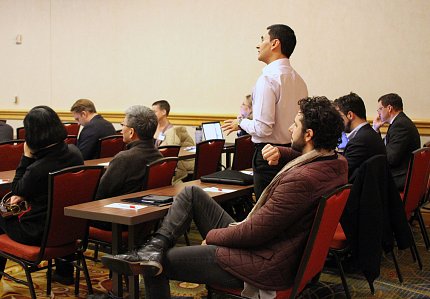Researchers Connect at 3rd BRAIN Investigators’ Meeting

Photo: Vivian Yang
The Bethesda North Marriott Hotel was invaded recently by a bunch of brainiacs—literally. For 3 days, engineers, mathematicians, neuroscientists, chemists and physicists met in workgroups to discuss the latest topics such as ultrasound neuromodulation, embedded ensemble encoding theory of brain circuits and genetically encoded voltage indicators.
In hallways, researchers discussed plans to collaborate and share resources. And in one large room, the aisles—formed by rows of poster boards—were crowded with scientists presenting their latest work. It was the third annual BRAIN Initiative Investigator’s meeting and, with more than 750 attendees, it was the biggest one yet.
Launched in 2013, the Brain Research through Advancing Innovative Neurotechnologies (BRAIN) Initiative is a large-scale effort funded by NIH, other government agencies and private organizations to equip researchers with new tools to interrogate and modulate brain activity. The hope is that these technologies will open a window onto the brain that will transform the diagnosis and treatment of brain disorders including schizophrenia, autism, epilepsy, chronic pain and traumatic brain injury.
“Our mission is to do nothing less than revolutionize our understanding of brain function,” said Dr. Walter Koroshetz, director of the National Institute of Neurological Disorders and Stroke. “BRAIN Initiative researchers are turning science fiction into reality.”
A major goal of BRAIN is to encourage researchers and organizations from diverse disciplines to work together. The annual meetings reflect this effort. Researchers and engineers from around the world were joined by staff from public and private partners and advocacy groups. In addition to presenting their latest scientific results, attendees discussed how researchers can work together and share data, techniques and technologies.
“We want to bring new people with fresh ideas into neuroscience research,” said Dr. Joshua Gordon, director of the National Institute of Mental Health. “There are as many engineers as neuroscientists working on BRAIN Initiative projects.”
Each morning of the meeting, attendees gathered in the main hall for plenary addresses from leading scientists. Immediately after, researchers met in a ballroom to discuss their latest results presented on posters. In the afternoons, attendees had a choice between small sessions where researchers made short presentations of their work, or large panel discussions on a range of topics including Global Efforts in Neurotechnology Development, Clinical Implications for BRAIN, NeuroEthics and Synergy of BRAIN Initiative Efforts.
Highlights included a brief history of the BRAIN Initiative by Thomas Kalil, formerly of the White House Office of Science Technology and Policy; a plenary talk on Brains, Behavior and Evolution by Dr. Cori Bargmann of the Chan Zuckerberg Initiative; a special evening panel on Exciting New Technologies from BRAIN co-moderated by NPR’s Joe Palca; and presentations by several of the initiative’s early stage researchers.
On the final day, NIH director Dr. Francis Collins announced that the recently passed 21st Century Cures Act assigned $1.51 billion over 10 years for the BRAIN Initiative and discussed the importance of making the public more aware of the initiative.
“I’m a huge fan of this program,” he said. “To see how far we have come has been truly gratifying…The BRAIN project will be successful if it changes the way in which everybody working in neuroscience approaches problems. Decades from now, I believe historians will write that by working together in novel ways, BRAIN Initiative researchers transformed the foundations of brain science and changed the course of medicine.”
